英语七年级上册Unit1教案人教版1
- 格式:doc
- 大小:37.50 KB
- 文档页数:2
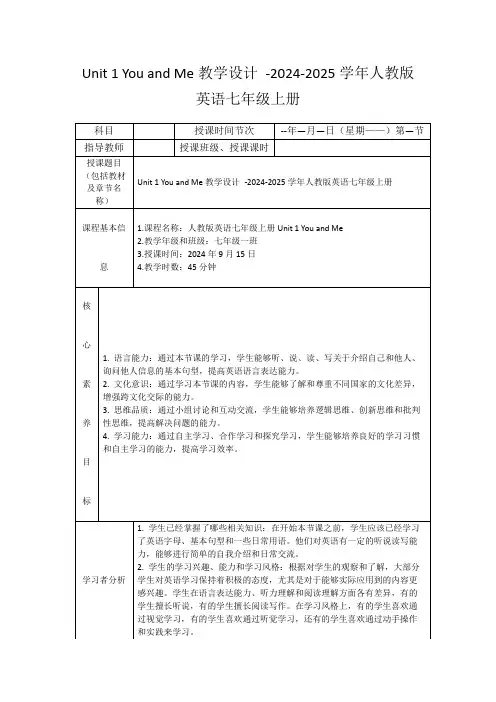
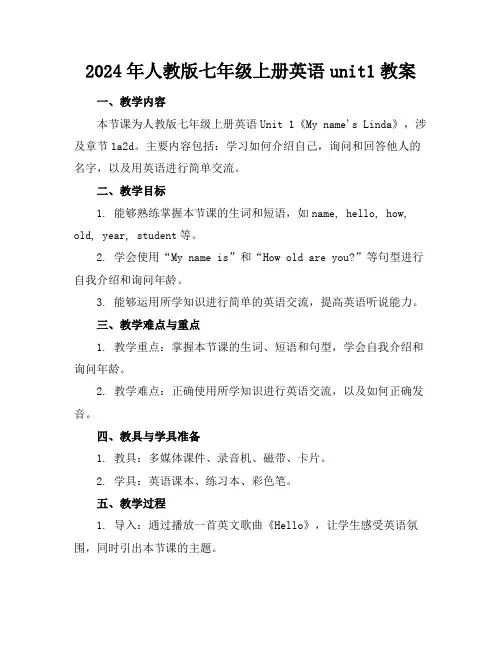
2024年人教版七年级上册英语unit1教案一、教学内容本节课为人教版七年级上册英语Unit 1《My name's Linda》,涉及章节1a2d。
主要内容包括:学习如何介绍自己,询问和回答他人的名字,以及用英语进行简单交流。
二、教学目标1. 能够熟练掌握本节课的生词和短语,如name, hello, how, old, year, student等。
2. 学会使用“My name is”和“How old are you?”等句型进行自我介绍和询问年龄。
3. 能够运用所学知识进行简单的英语交流,提高英语听说能力。
三、教学难点与重点1. 教学重点:掌握本节课的生词、短语和句型,学会自我介绍和询问年龄。
2. 教学难点:正确使用所学知识进行英语交流,以及如何正确发音。
四、教具与学具准备1. 教具:多媒体课件、录音机、磁带、卡片。
2. 学具:英语课本、练习本、彩色笔。
五、教学过程1. 导入:通过播放一首英文歌曲《Hello》,让学生感受英语氛围,同时引出本节课的主题。
2. 新课展示:展示多媒体课件,呈现本节课的生词、短语和句型,引导学生跟读并模仿。
3. 例题讲解:以PPT形式展示例题,讲解如何用英语进行自我介绍和询问年龄,并引导学生进行实际操作。
4. 随堂练习:发放练习纸,让学生两人一组进行角色扮演,练习自我介绍和询问年龄。
5. 小组活动:将学生分成若干小组,进行“Find your partner”的游戏,要求学生用英语进行交流,找到与自己年龄相仿的伙伴。
六、板书设计1. Unit 1 My name's Linda2. 生词:name, hello, how, old, year, student等3. 句型:My name is How old are you? I'm七、作业设计1. 作业题目:(1)抄写本节课的生词、短语和句型,每个三遍。
(2)用英语写一篇自我介绍,包括姓名、年龄和兴趣爱好。
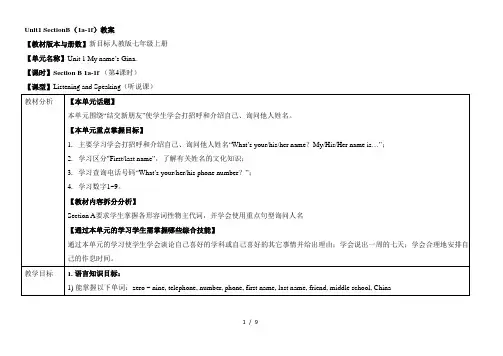
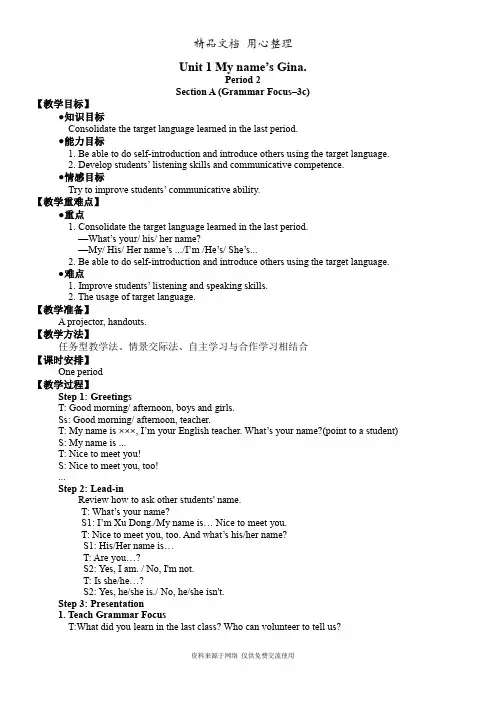
Unit 1 My name’s Gina.Period 2Section A (Grammar Focus–3c)【教学目标】●知识目标Consolidate the target language learned in the last period.●能力目标1. Be able to do self-introduction and introduce others using the target language.2. Develop students’ listening skills and communicative competence.●情感目标Try to improve students’ communicative ability.【教学重难点】●重点1. Consolidate the target language learned in the last period.—What’s your/ his/ her name?—My/ His/ Her name’s .../I’m /He’s/ She’s...2. Be able to do self-introduction and introduce others using the target language.●难点1. Improve students’ listening and speaking skills.2. The usage of target language.【教学准备】A projector, handouts.【教学方法】任务型教学法、情景交际法、自主学习与合作学习相结合【课时安排】One period【教学过程】Step 1: GreetingsT: Good morning/ afternoon, boys and girls.Ss: Good morning/ afternoon, teacher.T: My name is ×××, I’m your English teacher. What’s your name?(point to a student) S: My name is ...T: Nice to meet you!S: Nice to meet you, too!...Step 2: Lead-inReview how to ask other students' name.T: What’s your name?S1: I’m Xu Dong./My name is… Nice to meet you.T: Nice to meet you, too. And what’s his/her name?S1: His/Her name is…T: Are you…?S2: Yes, I am. / No, I'm not.T: Is she/he…?S2: Yes, he/she is./ No, he/she isn't.Step 3: Presentation1. Teach Grammar FocusT:What did you learn in the last class? Who can volunteer to tell us?S1:Me. We’ve learned how to introduce ourselves.S2:We’ve learned the use of verb be.S3:We’ve learned the possessive pronounces.T:Great! Today we’ll consolidate what we’ve learned in the last class.(1) Ask students to open their book, and turn to Page 3. Read through the sentences in the box.(2) Ask students to write down their answers to the questions, and substitute the names of the names of students in the box.(3) Leave students several minutes to do the task.(4) Collect their answers. Correct mistakes if there is any.(5) Ask students to read the short forms in the box. Pay attention to the pronunciation.2. Teach activity 3a(1) Look at 3a. Tell Ss to put the words in order to make conversations. Pay attention to theright sentence structure. Ss work with their partners. Try to make conversations with the given words.(2) Check the answers. Encourage some pairs to act out the dialogue. See if their dialogues are right.(3) Ss read the dialogue aloud after the teacher. Then try to practice the dialogues with their partners.(4) Let some pairs to act out the dialogue in front of the class.Step 4: Practice1. Teach activities 3b(1) Look at 3b. Tell Ss to complete conversation. Pay attention to the right sentence structure.Ss work with their partners. Try to make conversation.(2) Check the answers. Encourage some pairs to act out the conversations. See if their answers are right.(3) Ss read the conversations aloud after the teacher. Then try to practice the conversations with their partners.(4) Let some pairs to act out the conversations in front of the class.2. Teach activity 3c(1) Now, each of you has an English name. So we have learnt many names about boys and girls. Do you know how many foreign names? Let's do a "Name game".Competition: list names as many as possible, see which group gets the most names.(2) Divide the Ss into groups of six or more. Each group has four or six students.(3) Tell Ss how to play the game. Make a model for the Ss.S1: My name is Jenny.S2: Her name is Jenny. My name is Tony.S3: Her name is Jenny. His name is Tony…My name is June.S4: …(4) Ss play the game in their groups first. Then have a competition. See which group is the best.Step 5: ConsolidationSum up the possessive pronouns “my, your, his, her...”.Do exercises:1. What’s (你的) name?2. (我的) name is Jenny.= Jenny.3. What’s (他的) name?4. (他的) name is Tony.5. What’s (她的) name?6. (她的) name is Gina.Invite volunteers to present the answers.Answers:1.your 2. My; I’m 3.his 4.His 5.her 6.Her【课堂小结】In this period, we’ve consolidated what we’ve learned in the last period through some practice and games.【课后作业】1. Read the sentences in Grammar Focus.2. Make some conversations by yourself.。
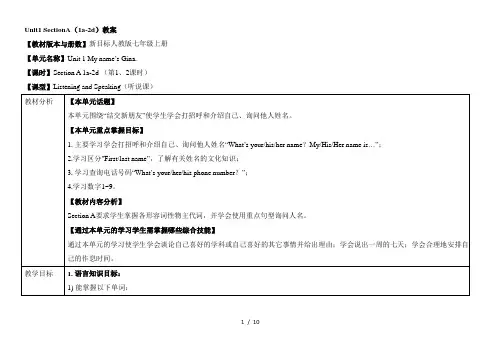
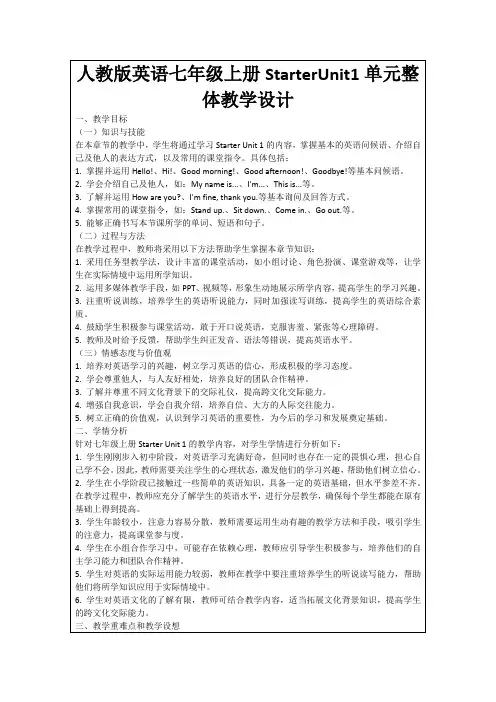
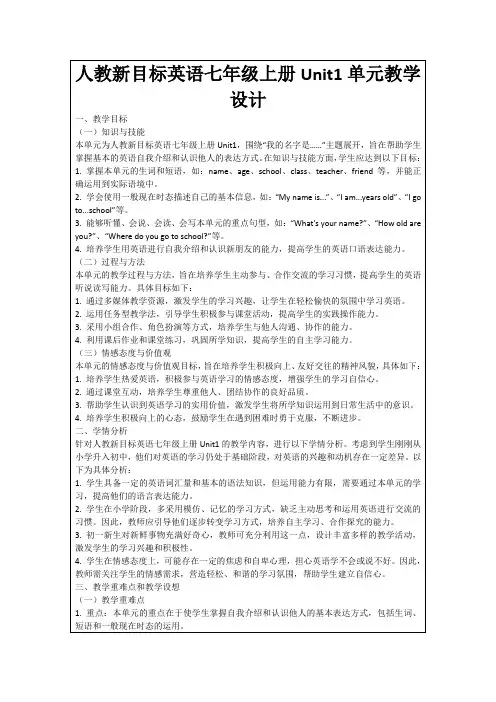
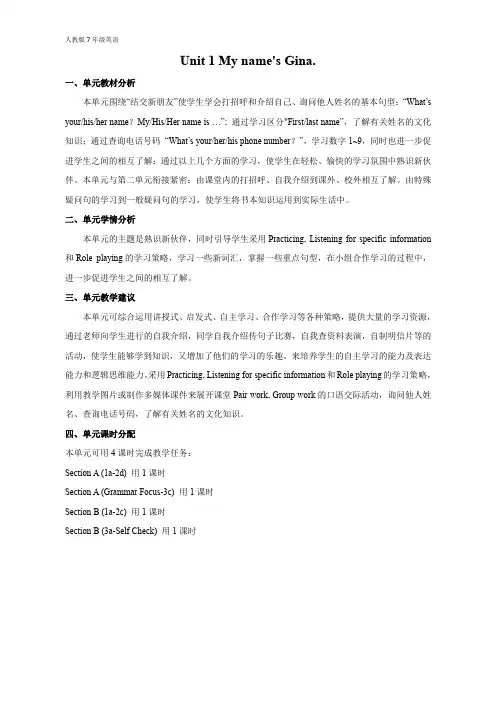
Unit 1 My name's Gina.一、单元教材分析本单元围绕“结交新朋友”使学生学会打招呼和介绍自己、询问他人姓名的基本句型:“What’s your/his/her name?My/His/Her name is …”; 通过学习区分"First/last name”,了解有关姓名的文化知识;通过查询电话号码“What’s your/her/his phone number?”,学习数字1~9,同时也进一步促进学生之间的相互了解;通过以上几个方面的学习,使学生在轻松、愉快的学习氛围中熟识新伙伴。
本单元与第二单元衔接紧密:由课堂内的打招呼、自我介绍到课外、校外相互了解。
由特殊疑问句的学习到一般疑问句的学习,使学生将书本知识运用到实际生活中。
二、单元学情分析本单元的主题是熟识新伙伴,同时引导学生采用Practicing, Listening for specific information 和Role playing的学习策略,学习一些新词汇,掌握一些重点句型,在小组合作学习的过程中,进一步促进学生之间的相互了解。
三、单元教学建议本单元可综合运用讲授式、启发式、自主学习、合作学习等各种策略,提供大量的学习资源,通过老师向学生进行的自我介绍,同学自我介绍传句子比赛,自我查资料表演,自制明信片等的活动,使学生能够学到知识,又增加了他们的学习的乐趣。
来培养学生的自主学习的能力及表达能力和逻辑思维能力。
采用Practicing, Listening for specific information和Role playing的学习策略,利用教学图片或制作多媒体课件来展开课堂Pair work, Group work的口语交际活动,询问他人姓名、查询电话号码,了解有关姓名的文化知识。
四、单元课时分配本单元可用4课时完成教学任务:Section A (1a-2d) 用1课时Section A (Grammar Focus-3c) 用1课时Section B (1a-2c) 用1课时Section B (3a-Self Check) 用1课时Section A (1a-2d)一、教学目标:1. 语言知识目标:1) 能掌握以下单词:name nice meet his and her your能掌握以下句型:①—Hi. My name’s Gina. —I’m Jenny. Nice to meet you!②—What’s your/his/her name? —My/his her name is…③—Are you…? —Yes, I am. / No, I'm not.④—Is he/she…? —Yes, she/he is. / No, she/he isn’t.2) 能了解以下语法:your, his, her等形容词性物主代词的简单用法;What’s=what is I’m=I am name’s=na me is等缩写形式。
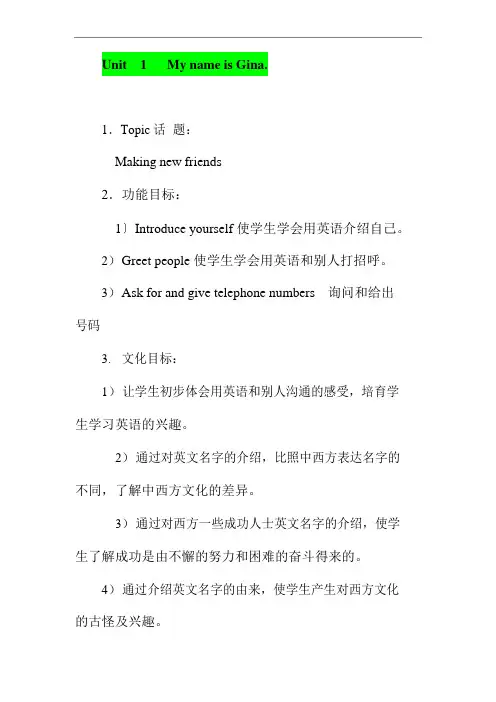
Unit 1My name is Gina.1.Topic 话题:Making new friends2.功能目标:1〕Introduce yourself 使学生学会用英语介绍自己。
2)G reet people 使学生学会用英语和别人打招呼。
3)A sk for and give telephone numbers 询问和给出号码3.文化目标:1)让学生初步体会用英语和别人沟通的感受,培育学生学习英语的兴趣。
2)通过对英文名字的介绍,比照中西方表达名字的不同,了解中西方文化的差异。
3)通过对西方一些成功人士英文名字的介绍,使学生了解成功是由不懈的努力和困难的奋斗得来的。
4)通过介绍英文名字的由来,使学生产生对西方文化的古怪及兴趣。
4.认知目标:1〕词汇:clock, hello, hi, and, question, answer, look, first name, last name2)语法工程:一般现在时be 的用法以特别疑问词what 开头的问句形容词性物主代词my, your, his, herWhat’s=What is I’m=I am My name’s=My name is3)Language goals 语言目标:What’s your name?My name is Gina.I’m Gina. Nice to meet you.What’s your telephone number? It’s….Period oneI.教材分析:这是课本的第一局部,题目是My mane is Gina. 有很多学生第一次学习接触英语,为了调动他们的乐观性,不产畏难心情,尽量简洁的处理教材。
Language topic: What’s your name?My name is Gina.Language strategies: Talk about the namesMain vocabulary: name is, meet, his, first name, last name, answer, boy , girl.II.语言结构: present tense to be, what questions, Possessive adj. my, your, his, her. 。
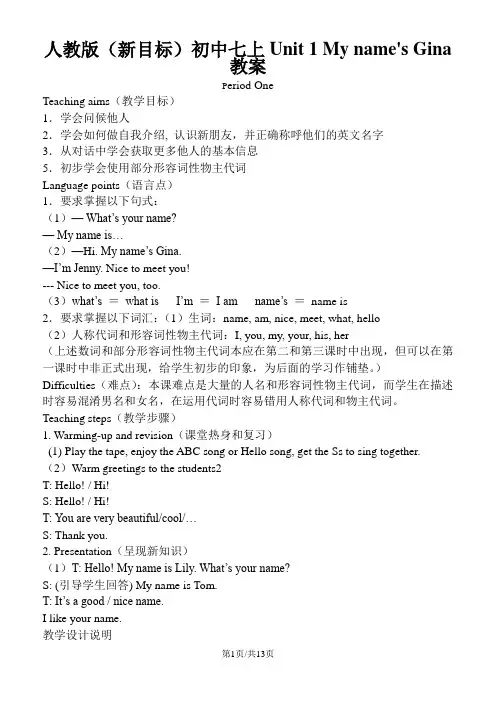
人教版(新目标)初中七上Unit 1 My name's Gina教案P eriod OneTeaching aims(教学目标)1.学会问候他人2.学会如何做自我介绍, 认识新朋友,并正确称呼他们的英文名字3.从对话中学会获取更多他人的基本信息5.初步学会使用部分形容词性物主代词Language points(语言点)1.要求掌握以下句式:(1)—What’s your name?—My name is…(2)—Hi. My name’s Gina.—I’m Jenny. Nice to meet you!--- Nice to meet you, too.(3)what’s =what is I’m =I am name’s =name is2.要求掌握以下词汇:(1)生词:name, am, nice, meet, what, hello(2)人称代词和形容词性物主代词:I, you, my, your, his, her(上述数词和部分形容词性物主代词本应在第二和第三课时中出现,但可以在第一课时中非正式出现,给学生初步的印象,为后面的学习作铺垫。
)Difficulties(难点):本课难点是大量的人名和形容词性物主代词,而学生在描述时容易混淆男名和女名,在运用代词时容易错用人称代词和物主代词。
Teaching steps(教学步骤)1. Warming-up and revision(课堂热身和复习)(1) Play the tape, enjoy the ABC song or Hello song, get the Ss to sing together. (2)Warm greetings to the students2T: Hello! / Hi!S: Hello! / Hi!T: You are very beautiful/cool/…S: Thank you.2. Presentation(呈现新知识)(1)T: Hello! My name is Lily. What’s your name?S: (引导学生回答) My name is Tom.T: It’s a good / nice name.I like your name.教学设计说明1.在课前放一段学生熟悉的英文歌曲,渲染学习气氛。

人教版七年级英语上册Unit1Myname'sGina教案人教版七年级英语Unit1 My name s Gina教案1. 让学生学会向别人做自我介绍,学会交朋友。
2. 学会使用与他人见面时的问候语。
3. 学会电话号码的表达方法并能向他人索取电话号码。
单元教学目标1. 语言知识目标1) 学生能听、说、读、写课标内单词 zero-nine,phone number,first name /last name , hi, hello 等。
2) 学生学会运用这些句型:a. what’s your/her/his nameb. hello. nice to meet you.c. what’s her last/first named. what’s your phone number it’s…2. 语言技能目标1) 能正确流利地用英语向他人介绍自己,并乐于与同伴交往。
2) 能正确使用问候语。
3) 能积极主动提供并获取个人信息资料(如:名字、电话号码)4) 能对所获取的信息进行初步的整理和总结。
5) 能归纳一定的语言现象。
(如:what is =what’s he is =he’s 等 )3. 学习策略目标a) 能积极与同伴合作,共同完成学习任务。
b) 能通过网络等多种资源获得相关信息,拓展所学知识。
c) 能积极动手、动脑,培养自己的想象力和创造力。
4. 情感态度目标1. 使学生对英语产生强烈的兴趣和愿望,乐于参加各种语言实践活动。
2. 能与伙伴团结一致、友好相处,学会如何礼貌地与他人交往。
5. 文化意识目标1. 学生能了解和运用英语中常见的问候语。
2. 能初步了解英语国家的姓名。
教学重点1. 让学生学会自我介绍,学会交朋友。
2. 正确使用问候语。
3. 能听懂并说出0-9的数字。
教学难点1. 能正确使用人称代词my , your, his, her, i2. 英语名字的认读怎么学习英语最快好制定了学习英语计划,首先,从提高阅读能力开始。
Unit 1词汇篇_______________________________________________________________________________ _______________________________________________________________________________熟练掌握本单元重点词组句型。
(1)“ My name's..”和“I`m…”是自我介绍时的常用句型,分别意为“我的名字叫…”和“我是/叫…”,后者比前者显得更随意些。
其中 name's=name is,I`m=I am 。
(2)name 是可数名词,意为“名字;名称”。
>>.My name is Sally. 我的名字叫萨莉。
注意:招呼可以这么打非正式场合 熟人之间初次见面经人介绍后Unit1单元语法一、一般现在时中be 动词的用法1.be 动词的形式:在一般现在时中,be 动词有三种形式,即am 、is 、are 。
2.be 动词的用法3.be动词的句式二、形容词性物主代词1. 概述:英语中表示所有关系的代词为物主代词。
物主代词形容词性物主代词(相当于形容词) 修饰 名词名词性物主代词(相当于名词)2. 形容词性物主代词形容性物主代词含义第一人称 my 我的3.形容性物主代词的用法(1)形容性物主代词修饰名词,作名词的定语。
>>It is my cup.这是我的杯子。
(2)形容词性物主代词与形容词一起修饰名词时,其顺序为“形容词性物主代词+形容词+名词”。
>>My new bag is here.我的新书包在这儿。
(3)若名词前有形容词物主代词修饰,其前就不能再用冠词或指示代词。
形容词性物主代词冠词(a、an、the)修饰名词指示代词(this、that...>>This is my sister. Her name is Alice. 这是我的姐姐。
2024年人教版七年级上册英语unit1标准教案一、教学内容本节课教学内容来自2024年人教版七年级上册英语Unit 1《My name's Linda》。
具体包括:Section A 1a2d,主要围绕“见面和自我介绍”这一主题展开,涉及日常交际用语、名词、形容词性物主代词、be动词等知识点。
二、教学目标1. 能够听懂、会说、会读、会写与“见面和自我介绍”相关交际用语,如:“Hello, my name is”, “What's your name?”, “I'm”等。
2. 能够正确运用名词和形容词性物主代词,介绍自己和他人名字、年龄、爱好等。
3. 能够运用be动词一般现在时形式,描述自己和他人特点。
三、教学难点与重点1. 教学重点:名词、形容词性物主代词和be动词一般现在时正确运用。
2. 教学难点:如何引导学生运用所学知识点进行自然自我介绍和交流。
四、教具与学具准备1. 教具:多媒体课件、录音机、磁带、黑板、卡片等。
2. 学具:课本、练习本、彩色笔等。
五、教学过程1. 引入:通过播放一首英文歌曲《Hello, how are you?》,引导学生进入英语学习状态,同时复习上节课知识点。
2. 新课展示:(1)展示Section A 1a图片,引导学生观察并回答问题,如:“Who are they?”等。
(2)播放1a录音,让学生跟读并模仿,掌握“Hello, my name is”等交际用语。
(3)引导学生相互介绍,进行小组活动。
3. 例题讲解:(1)讲解2a例题,让学生解如何用be动词描述自己特点。
(2)引导学生进行2b练习,巩固所学知识点。
4. 随堂练习:(1)让学生完成2c练习,相互询问对方名字和年龄。
(2)引导学生进行2d小组活动,练习自我介绍。
六、板书设计1. 主题:My name's Linda2. 内容:(1)交际用语:Hello, my name is / What's your name? /I'm(2)名词:name, age, hob等(3)形容词性物主代词:my, your, his, her等(4)be动词一般现在时:am, is, are七、作业设计1. 作业题目:(1)抄写并背诵本节课交际用语和重点句型。
Unit 1重点句型汇总
Section A
1. Where is your pen pal from?
●come from和be from是同义短语,但come from更强调动作。
如:
—Where do you come from? 你从哪里来?
—I come from the United Kingdom. 我从英国来。
●句型“Where + be + sb. + from?”通常用来询问“某人来自什么地方”。
如:—Where are you from? 你是哪里人?
—I’m from Shanghai. 我是上海人。
●句型“Where + be + sth. + from?”通常用来询问“某物品产自哪里”。
如:—Where is the car from? 这辆轿车产自哪里?
—It’s from France.它产自法国。
2. —Where does he live?
—Tokyo.
●live作不及物动词,意为“生活,居住”,后常接in + 地点名词或直接接表地点的副词here / there / home等。
如:
We live here / in New York. 我们住在这儿/ 纽约。
●live还可表示“过着……生活”,此时为及物动词。
如:
We live a happy life. 我们过着幸福的生活。
3. What language does she speak?
●what language常用来对“某种语言”进行提问。
●speak意为“说,讲”,后面常接表语言的名词。
如:
Can you speak French? 你会讲法语吗?
Section B
1. Does she have any brothers or sisters?
any意为“一些”,常用于疑问句或否定句中,修饰可数名词复数形式或不可数名词。
如:
There isn’t any milk in the glass. 杯子里没有牛奶。
2. I can speak English and a little French.
a little意为“少量,一点儿”,常修饰不可数名词,具有肯定意义;little意为“几乎没有”,修饰不可数名词,具有否定意义。
如:
There’s a little water in the cup. 杯子里有点儿水。
He knows little English. 他几乎不懂英语。
3. Can you write to me soon?
write to sb. 意为“给某人写信”。
如:
Please write to Jack.请给杰克写封信。
此短语常用于书信的结尾,提示别人尽快写回信。